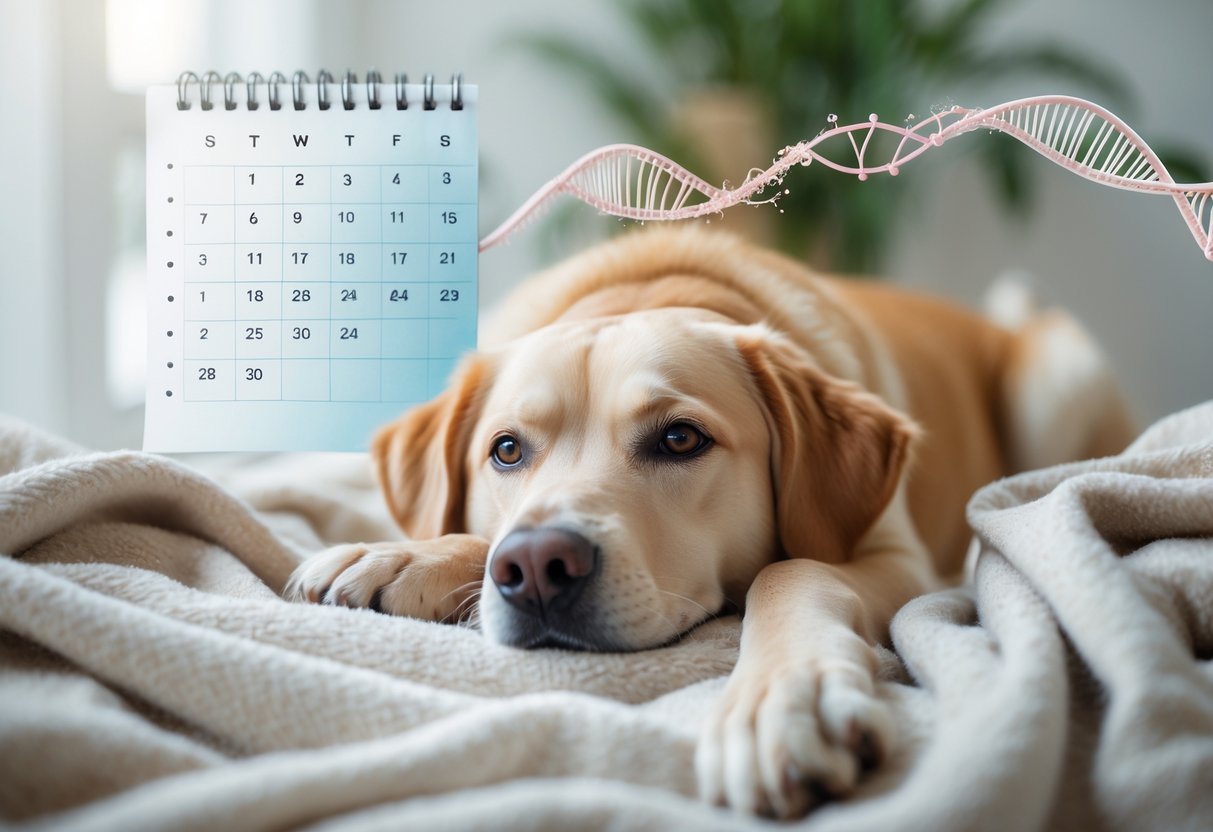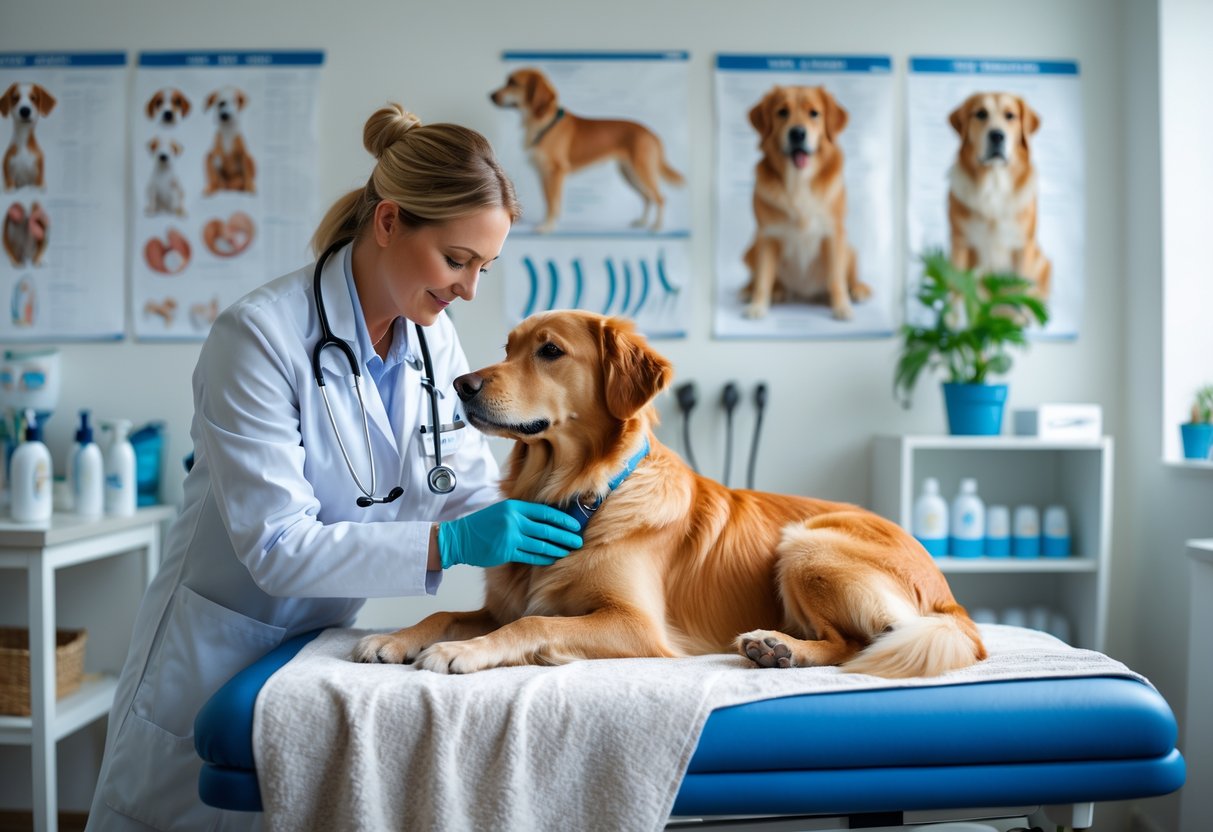How Long Are Dogs Pregnant? Essential Information and Timeline

Dogs are pregnant for about nine weeks, with the average gestation lasting around 63 days from ovulation. This period can vary slightly, usually between 58 and 68 days. Knowing the length of pregnancy helps owners and breeders prepare for the arrival of puppies and care for the mother during this critical time.
The pregnancy begins after ovulation, when fertilization occurs, and the developing puppies start to grow inside the uterus. Symptoms in the early weeks might be subtle, making it important to track the reproductive cycle closely. As the pregnancy progresses, signs become clearer, and proper care becomes essential to support the mother and her litter.
Understanding the timeline of a dog’s pregnancy allows for timely vet visits, ultrasound checks, and preparation for whelping. Being aware of these stages helps ensure a smooth and healthy experience for both the dog and her puppies.
Key Takeaways
- Dogs are pregnant for about 63 days on average, with some variation.
- Early pregnancy signs can be subtle, requiring careful observation.
- Proper care and timing are crucial for a healthy pregnancy and delivery.
Understanding the Canine Reproductive Cycle
The canine reproductive cycle is divided into four main stages that affect when a female dog can become pregnant. Each phase involves hormonal changes that influence behavior and physical signs. Knowing these stages helps with timing for breeding and care during pregnancy.

Proestrus Stage
Proestrus is the first phase of the cycle, lasting about 6 to 11 days. During this time, estrogen levels rise, causing the female’s vulva to swell and produce a bloody discharge. She may attract male dogs but typically will not allow mating yet.
Behavior changes can include increased restlessness and more frequent urination. This phase signals the start of the heat cycle but isn’t the optimal time for breeding since ovulation hasn’t occurred yet. Proestrus duration can vary widely between dogs, sometimes lasting from 3 to 21 days.
Estrus Stage
Estrus follows proestrus and is when the female becomes fertile and receptive to males. This phase usually lasts 5 to 9 days but can range from 10 to 20 days in some dogs. Ovulation happens during estrus, triggered by a surge in luteinizing hormone (LH).
Physical signs include a softer, enlarged vulva and a discharge that lightens in color. Hormone levels shift: estrogen drops while progesterone rises. This is the critical window for successful breeding, as eggs mature and are ready for fertilization.
Diestrus Stage
Diestrus begins after estrus and lasts about 60 days, regardless of pregnancy status. Progesterone remains high to maintain a possible pregnancy during this phase. The vulva returns to normal size, and discharge decreases.
If the female is pregnant, this stage supports fetal development. If she is not pregnant, hormones balance out as the body resets. The bitch will refuse mating during diestrus. Monitoring hormone levels during this time can help confirm pregnancy.
Anestrus Stage
Anestrus is the resting phase between heat cycles, lasting roughly 4 to 6 months but sometimes up to 12 months, depending on the dog and breed. Hormones are at low levels, and the reproductive tract returns to normal.
During anestrus, the uterus repairs itself. The dog shows no signs of heat or fertility. This phase prepares the dog’s body for the next cycle and is important for overall reproductive health and timing of future breeding efforts.
Typical Gestation Period in Dogs

The pregnancy length in dogs is usually consistent but can vary slightly depending on several factors. Knowing the timeframe helps in preparing for the arrival of puppies and monitoring the health of the pregnant dog.
Normal Range of Dog Pregnancy Length
Dogs are pregnant for about 58 to 68 days, with the average gestation period being approximately 63 days. This is roughly nine weeks from ovulation, not mating, since sperm can survive in the female reproductive tract for several days before fertilization.
Breeders and veterinarians typically use the ovulation date or a hormonal surge to estimate the due date. Counting from the first day a female dog allows mating can be less accurate because ovulation timing varies. Most dogs give birth between days 57 and 65 after fertilization.
Factors That Affect Gestation Period
Several factors can change the length of a dog’s pregnancy. Breed size plays a role; smaller breeds tend to have slightly shorter gestation periods of around 58 to 60 days. Larger breeds may have pregnancies lasting up to 65 or 67 days.
The litter size can also influence pregnancy length. Larger litters sometimes lead to earlier births, while smaller litters might result in slightly longer pregnancies. Individual health and environmental conditions, such as stress and nutrition, can affect the timing as well.
Week-by-Week Breakdown of Pregnancy

Dog pregnancy lasts about 63 days. During this time, the mother dog’s body changes a lot as the puppies develop. Her care and diet need to adjust to support both her and the growing puppies.
Weeks 1-3: Early Development
Pregnancy begins with fertilization. The fertilized eggs divide and move to the uterus in the first two weeks. At this stage, physical signs are usually not visible.
By the third week, the eggs implant in the uterine lining. Slight belly swelling may appear, but it is often hard to notice. Behavioral changes like tiredness or reduced appetite can start to show.
Veterinary confirmation through blood tests or ultrasounds is possible at this time. Nutrition should remain the same, but close monitoring should begin.
Weeks 4-6: Rapid Fetal Growth
From week 4, fetuses grow quickly, reaching 2-7 cm by week 6. The dog’s abdomen enlarges and breasts swell as her body prepares for nursing.
An ultrasound can detect the puppies and their heartbeats from week 4-6. Appetite usually increases, so daily food intake should gradually rise by about 5% weekly starting at week 5.
Exercise should be gentle, and a quiet, safe space should be set up for the dog as she grows.
Weeks 7-9: Final Preparation and Changes
By week 7, puppies’ bones begin to harden. An X-ray is recommended to count puppies and check for problems with delivery.
The mother’s appetite may decrease near the end. Feeding smaller, frequent meals helps. Nesting behavior starts as she prepares for labor.
Puppies are fully formed by week 9 and ready for birth. The whelping area should be clean, quiet, and comfortable. Watch closely for early labor signs and keep the vet contact handy.
Recognizing Signs and Confirming Pregnancy

Recognizing pregnancy in a dog involves observing clear physical and behavioral changes. Confirming pregnancy usually requires a visit to the veterinarian, who can use specific methods to verify it. Both attention to changes in the dog and professional tests help ensure accurate diagnosis.
Physical and Behavioral Changes
A pregnant dog often shows early signs like decreased appetite and mild vomiting similar to morning sickness in humans. After a few weeks, her nipples will enlarge and darken. Weight gain becomes noticeable around mid-pregnancy.
Behavior changes include increased tiredness, more affection, or a desire for solitude. Later, her abdomen will swell as puppies grow. She may drink more water and urinate more often. Just before labor, nesting behavior appears—she looks for quiet, comfortable places to give birth.
Veterinary Methods for Confirmation
Veterinarians use several reliable methods to confirm pregnancy. Ultrasound is common and can detect fetal heartbeats as early as 21 to 28 days after breeding. It helps check puppy health and estimates litter size.
Palpation involves gently feeling the abdomen to detect developing fetuses, usually done between 21 and 28 days, but it’s less effective for larger or overweight dogs. Relaxin blood tests detect pregnancy hormones around 25 to 30 days. Later, X-rays around day 45 show fetal skeletons and help count puppies accurately.
Preparing for Whelping and Care

A dog needs a clean, quiet space and close monitoring as she prepares to give birth. Proper preparation helps reduce stress and ensures she and her puppies stay safe during labor and delivery.
Setting Up a Whelping Box
A whelping box gives the dog a safe place to deliver her puppies. It should be large enough for her to lie down comfortably and allow room for the puppies to move around.
The box should have low sides so the mother can enter and exit easily but high enough to keep puppies inside. Use soft, washable bedding like towels or blankets, and change them often to maintain cleanliness.
Place the box in a warm, draft-free room with a temperature around 75°F (24°C). Keep it quiet and away from heavy foot traffic to minimize stress. Include clean water and food nearby but outside the box to avoid mess.
Monitoring the Whelping Process
Close watch is essential once labor begins. The dog will typically show restlessness, panting, and nesting behavior as she enters pre-labor.
Contractions can last from a few minutes up to several hours before puppies start arriving. It is normal for breaks of up to two hours between puppies.
Check for signs of distress, such as excessive bleeding or no progress after one hour of strong contractions. Having a vet’s contact ready is important in case of complications.
After birth, ensure the puppies start nursing quickly and that the mother cleans them, as this helps stimulate breathing and warmth.
Puppy Count and Postpartum Considerations

Knowing how many puppies a dog is carrying helps prepare for a safe delivery. After birth, proper care for the mother and her puppies is essential for their health and recovery.
Determining Number of Puppies
Vets can estimate the number of puppies using an X-ray after about 44 days of pregnancy. This timing is ideal because the puppies’ skeletons are visible and the risk to them is low.
Ultrasounds can detect pregnancy earlier but are less accurate in counting puppies.
Knowing the exact litter size helps ensure all puppies are delivered and no complications occur.
It also helps prepare appropriate space, food, and supplies for the puppies.
Post-Birth Care for Mother and Puppies
After delivery, the mother should be in a warm, quiet place with easy access to water and food. Her rest is vital for milk production and recovery.
Monitor the puppies to make sure they nurse properly and stay warm. Puppies cannot regulate their body temperature well during the first few weeks.
The mother may clean her puppies and stimulate their urination and defecation. If she does not, the caregiver may need to assist.
Watch for signs of illness in the mother such as heavy bleeding or refusal to eat, and contact a vet if concerns arise.

Frequently Asked Questions
A dog’s pregnancy lasts about 63 days and goes through several clear stages. Early signs include changes in appetite and behavior. Owners should monitor their dog’s health closely and prepare for delivery by recognizing the signs of labor.
